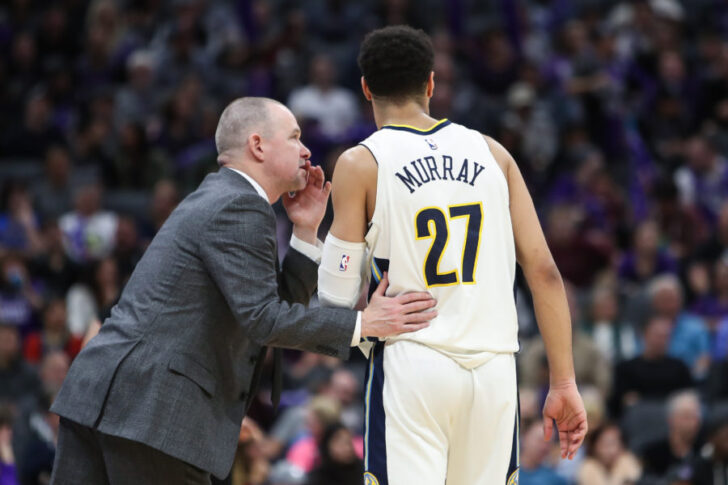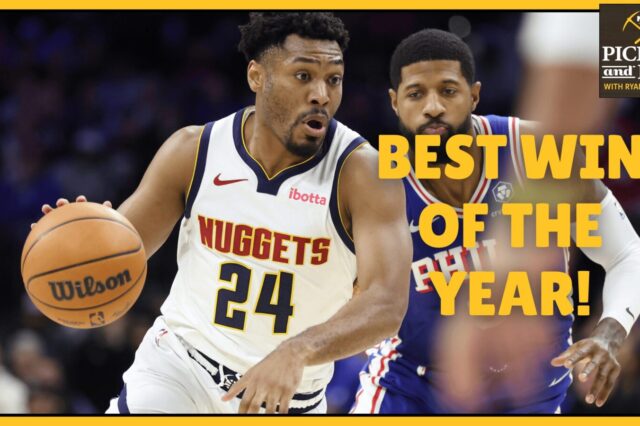The Denver Nuggets have a special weapon in Nikola Jokic. In addition to his touch as a shooter and his craft as a passer, Jokic is also one of the league’s better finishers near the rim. He can do it all on the offensive end, and the best version of the Nuggets is one where the ball is in his hands as much as possible.
Running your offense through your best player is easy enough when they’re a primary ball-handler. There’s not much the defense can do can do to keep the ball out of the hands of the likes of Stephen Curry, Russell Westbrook, or LeBron James — but it’s a little different for big men in today’s game. For Jokic to make an impact, Denver must actually get the ball to him first. That sounds simple enough, but the Nuggets have struggled in this regard all year long — especially in post-up situations.
Denver’s core is comprised of Jokic and two very young guards in Gary Harris and Jamal Murray. The latter two players have shattered their projections and raised the expectations both for themselves as individuals and for the team as a whole. There is very little that these two players struggle with, but their post entry passing leaves plenty to be desired.
That’s particularly problematic for the two guards who share the most court time with Jokic, but Murray and Harris aren’t the only ones who struggle with this. In fact, most of this team struggles with their post feeds, and it isn’t lost on the Nuggets’ coaching staff.
“We’ve had to do a lot of drills working on when our big guy is open in the post and being able to deliver that pass on time and on target,” Nuggets’ coach Michael Malone told the media during a recent shootaround. “Jamal, Gary, Will — all of our players have struggled with that at times and it’s something that we’re aware of and something we are trying to improve on as well.”
While the post up has seen a dramatic decline in its prevalence in the modern NBA, Jokic is an adroit scorer, and perhaps the best passing big man on the planet. According to Synergy, ‘the Joker’ creates 1.06 points per possessions on all post up plays when including ones that end in passes. That’s not quite the elite mark that he put up last year, but it still rates as “very good” in Synergy’s play-type database. Posting Jokic up is a great way offense for Denver.
Allowing the big Serbian to go one-on-one with a favorable matchup in the post is almost a concession — a wave of the proverbial white flag. But double-teaming the all-seeing Serbian is a dangerous proposition as well being that he is bound to locate the open man. A defenses’ best bet for avoiding this conundrum is doing their work early to deny him the ball. Teams have done that, and the Nuggets’ offense has yet to successfully adapt to these concerted efforts.
“Sometimes they struggle with that yeah,” Nikola Jokic admitted to the media during a recent shootaround. “But J.B. (player-development coach John Beckett) and Stephen Graham are working closely with them on that. They’re improving their game, they’re getting better.”
It’s important to note that the three players typically involved in this action are all below the age of 24. There’s time for them to grow in this regard but this isn’t something that can be fixed overnight.
Denver’s issues range from a lack of composure when the initial look is denied, to a lack of touch, to an inability to find the angle on the pass, to downright laziness. Watch as Murray telegraphs a pass to Jokic as he works to post up high on Ersan Ilyasova.
These next two feeds aren’t to Jokic, but the hurriedness from Harris is painfully evident here. He tries to squeeze the ball through that angles that are closing, or already have.
https://youtu.be/tuH9g-rIgCQ
It is clear from watching Harris try to get the ball in the post that he is still learning and adapting better angles to get the pass where it needs to be. He is still getting comfortable doing so and so are the rest of his teammates.
In the examples below from Barton and Lyles, the initial look is denied and the composure flies out the window. The ball could be reset in these examples, but Barton forces the issue, and Lyles decides to take a dribble towards the incoming Jokic, minimizing the space that’s needed to make that pass effectively.
These examples all result in turnovers, but they do not show another issue Denver has — recognizing what needs to be done to get Jokic the ball when he has a mismatch. Sometimes they simply just don’t see him, and sometimes, when the initial look is denied, rather than swinging the ball and making multiples passes with the intention of going back to him, Denver simply gives up on the opportunity.
“Our whole team has struggled making the entry pass to the post — it’s a dying art,” Malone told the media. “I think a lot of guys have no idea how to feed the post. Believe it or not, part of coaching and teaching in the NBA now is, you get all these young guys that have played AAU basketball and one or two years in college, but they come here and they lack some of the basic fundamentals.”
Malone might be right that these problems extend beyond Denver and permeates the young, scoring-first players that now populate the NBA. Basketball is a different game than it once was. Kids in AAU and high school might be more inclined to work on their outside shot or how to operate a high pick-and-roll than something like post feeds. As the game progresses, it appears that these types of fundamentals have slipped through the cracks.
A good example of a team with a true weapon down low — but also equipped with the fundamentals to get him the ball where, and when, he needs it — were the San Antonio Spurs of old. They were the kings of ball movement and the beneficiaries of Tim Duncan’s remarkable combination of gravity and basketball IQ.
Pre-Beautiful Game beautiful game. pic.twitter.com/qvIY4i8nqj
— Sarah (@WildHorses65) February 19, 2018
In the clip above, the Spurs identify that Duncan has a mismatch, but he’s being fronted by his defender. They don’t force the ball down low, and they don’t panic — they reset. They make multiple passes until Duncan has favorable positioning. The ball goes to Duncan, the double comes, and ‘the big fundamental’ knows exactly what to do.
That’s not exactly what it looks like when Denver’s guards look to get their big men the ball. Then again, that’s not really what basketball looks like anymore.
“I think it’s just the new generation,” Nuggets assistant Stephen Graham told Mile High Sports in an exclusive interview. “Bigs are able to step out and spread the floor — they’re shooting bigs now. Back in the day, when I was playing, and before that, you played inside-out. You get the ball to your bigs. It’s a different game now. Guys are trying to learn how to post feed. It’s a process.”
With Millsap returning to the lineup, the Nuggets have another big-man with a similar ability to punish defenses when posting up. It’s important that they make these improvements if they hope to unlock the best version of themselves. Of course, there will be a reintegration period as Millsap works his way back into this offense. If the team lacks chemistry with Jokic in this regard, they aren’t likely to have perfected the action with Millsap. But that’s more of the same for these Nuggets; a team riddled with injuries, defined by youth and trying desperately to find chemistry in real time.
Graham and the rest of the staff have worked diligently with the young guards to help prepare them for these situations, but Graham stressed that this isn’t an overnight fix. It takes time, it takes reps, and it takes familiarity, and Jokic agrees.
“They just need to know me, because this is kind of the first year that we’ve really played through me in the post,” Jokic told Mile High Sports. “So they just need to learn and I just need to learn. It’s just small things, but we are improving.”
Jokic is right — this is a small detail, a nit-pick of a team that performs well on the offensive end. But as the Nuggets continue to push the expectations higher and climb into the national conversation, it’s the small things that will come into focus. Two of Denver’s best players operate out of the post and their best offense flows through no. 15 so learning how to efficiently get the ball into the post is a crucial step in their development.
“It just comes with playing with each other over-and-over-again,” said Graham. “They’ll get there.”



